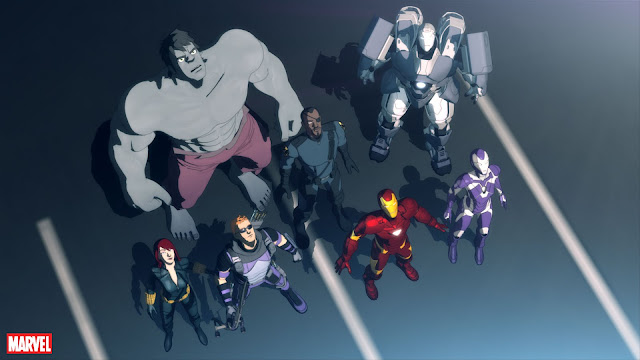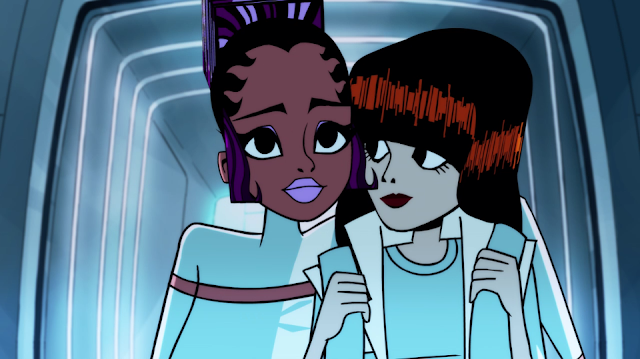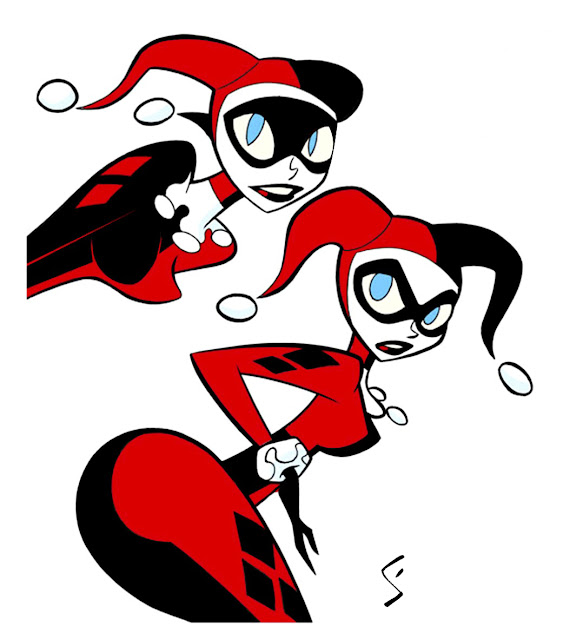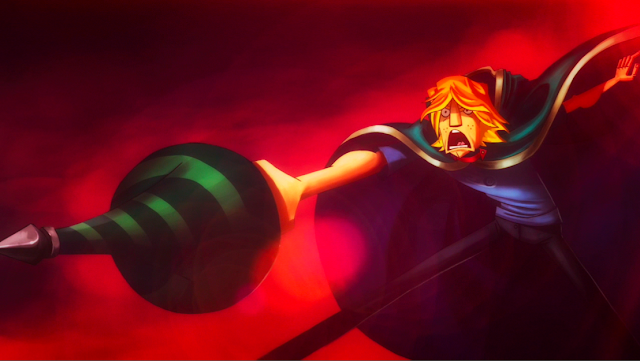 |
| All Hipster Fred can think about right now is where he could score some PBR. |
Each Tuesday in "5-Piece Cartoon Dinner," I dine on five of the week's most noteworthy animated cable shows that are found outside my Adult Swim comfort zone. The episodes are reviewed in the order of when they first aired.
Iron Man: Armored Adventures, which centered on a teenage version of inventor/superhero Tony Stark (Adrian Petriw), quietly ended its two-season run on Nicktoons last Wednesday. The animation on this Canadian-made show isn't bad for a CG-animated show. I like how at the end of the Rooney-soundtracked opening titles--nice original theme, by the way, from Dweezil Schwartzman or whatever his name is--Iron Man quivers like Buzz Lightyear pressing his wrist laser button while he activates his suit's repulsor ray from his palm, which makes it look as if this much younger Tony is still adjusting to the power of his repulsor rays. But the show's human character designs and lighting look cheap and low-res compared to what we see on other CG shows like Disney's noir-tinged Tron: Uprising and Bruce Timm's strikingly lit Green Lantern: The Animated Series.
While I find the look of Armored Adventures to be on the undernourished side, the writing, supervised by story editor Brandon Auman, is pretty decent. Though Armored Adventures is made for an audience that's younger than, say, Young Justice's--hence the de-aging of Tony, James Rhodes (Daniel Bacon) and Pepper Potts (Anna Cummer), who, instead of being Tony's assistant, is Tony and Rhodey's classmate on this show--it isn't as juvenile as I often find the writing on Ultimate Spider-Man to be. In other words, there aren't any anvillicious voiceovers from Tony or forced cutaway gags. I particularly liked Armored Adventures' recent crossover with the X-Men characters, the Auman-scripted "X-Factor," which had Tony and Rhodey coming to the aid of their mutant classmate Annie, who was on the run from Magneto and was revealed at the end of the episode to be a young Jean Grey.
In "The Makluan Invasion, Part 2: Unite!," Armored Adventures' series finale, the battle between Iron Man's allies and the Makluan forces for the coveted 10 Rings resembles the climax of Joss Whedon's The Avengers (this two-parter's team of heroes is the same as Whedon's roster, except it's missing Captain America, Thor and Maria Hill, who's Russian-accented on this show for some odd reason, and in their place is Black Panther), but Auman actually wrote the finale before Whedon began work on his movie. Hulk (Mark Gibbon) surprises his friends by joining them late in battle like in Whedon's movie, but he's a lot different here. He experienced an intelligence boost during his last appearance on the show, so he talks in full sentences (just like on The Avengers: Earth's Mightiest Heroes) and would be able to land a job as an ESL teacher. (The most physical side effect of Hulk's added brainpower was a change in skin color from green to '60s comics-era gray.)
A couple of other major differences between "The Makluan Invasion" and the Whedon movie are the involvement of War Machine and Rescue, Pepper's armored alter ego (which probably pleases female viewers who are campaigning for Gwyneth Paltrow's Pepper to suit up as Rescue in Iron Man 3), and due to the low budget, a reduced sense of scale. The Manhattan streets on this show are often empty. Where did all the bystanders go? Without those civilians, the battle between Team Stark/S.H.I.E.L.D. and the titular aliens isn't as high-stakes as the one between the Avengers and the Chitauri. Maybe that's also due to the fact that I'm in TV-Y7-land here instead of the PG-13-level alien-invasion drama of the Whedon film or the more morbid turf of a celeb-slaughtering Irwin Allen disaster flick, so I shouldn't be expecting Robert Wagner running around on fire like Richard Pryor or something.
Auman wrote "The Makluan Invasion" as both a season finale and series finale in case the series didn't get renewed. So because Nicktoons has basically cancelled Armored Adventures, the series concludes with Iron Man, War Machine and Rescue flying off into the sunset and eagerly looking forward to their new lives as superheroes whose secret identities are now known to the public, which learns of their unmasked selves after Tony accidentally loses his helmet while escaping the destruction of the Makluan mothership, and Rhodey and Pepper happen to be be unmasked when they retrieve him. Rhodey and Pepper's parents also learn of their children's secret lives and are unusually understanding about their new jobs. I'm surprised that Rhodey's lawyer mother Roberta (Catherine Haggquist) doesn't ask her son something like, "Hey, remember that internship at Matt Murdock's firm? Because in case the superheroing thing doesn't work out... Also, they've got dental."
***
The comedic material on Ultimate Spider-Man is much less cringe-inducing than usual this week. I don't know if it's because Scott Mosier--the Kevin Smith crony and SModcast network co-founder who co-wrote this week's "Beetle Mania" episode and had a hand in several other upcoming episodes--has something to do with it (I don't listen to Mosier and Smith's podcasts, so I can't tell which lines in "Beetle Mania" are ones Mosier would come up with). I actually laughed during one gag (Peter imagines the ambitious, Tara Strong-voiced Mary Jane as the new boss of the Bugle and pictures her with J. Jonah Jameson hair) and enjoyed another that requires the pause button in order to see it (a Bugle news channel ticker posts items like "Snow in July? Storm refuses to comment" and "Alison Blaire's new album goes platinum in the first week," a reference to Dazzler, the mutant pop singer from the X-Men comics).
Again, the C-list villain in the show's cold open, the recurring, bad glue pun-loving nuisance known as the Trapster (Steven Weber), is more memorable than the main heavy, the nearly mute Beetle (Steve Blum), whom Spidey and the S.H.I.E.L.D. trainees must protect both MJ and Jameson from when the armored assassin attempts to attack the outspoken Bugle editor-in-chief at his office building, just when MJ happens to be there to be interviewed by Jameson for a Bugle internship. The main villains on Ultimate Spider-Man have tended to be on the boring and easy-to-defeat side, including this week's uninteresting titular foe and the one-note Venom, although the Mark Hamill-voiced Nightmare from the Doctor Strange episode had, for once, some personality and formidableness (he kept everyone in New York imprisoned in their nightmares, which makes that small-town menace Freddy Krueger look like a pussy) and required more than just webbing and brute strength from Spidey in order to be defeated.
Series composer Kevin Manthei's half-orchestral/half-punk score music really stands out this week. He gives MJ a memorable and charming leitmotif for strings that perfectly suits the aspiring journo's persistent yet relaxed demeanor. And then someone in the Disney XD control room apparently got his drank on all Saturday night and was asleep at the wheel because he forgot to squeeze out the Ultimate Spider-Man end credits with one of Chi McBride's "Fury Files" segments for the "Marvel Universe" block, so we got to hear all of Manthei's end credits theme, which Manthei has referred to as a punk tune that "continues the tradition of the classic animated Spider-Man song in terms of being catchy." Manthei wrote it so that someone can easily sing "Spider-Man, Spider-Man" repeatedly over it, much like the late, great Shirley Walker's theme for the Man of Steel on Superman: The Animated Series. I may not always agree with Ultimate Spider-Man's comedic or narrative choices, but it's nice to hear an animated Marvel series step its game up in terms of score music for a change.



































